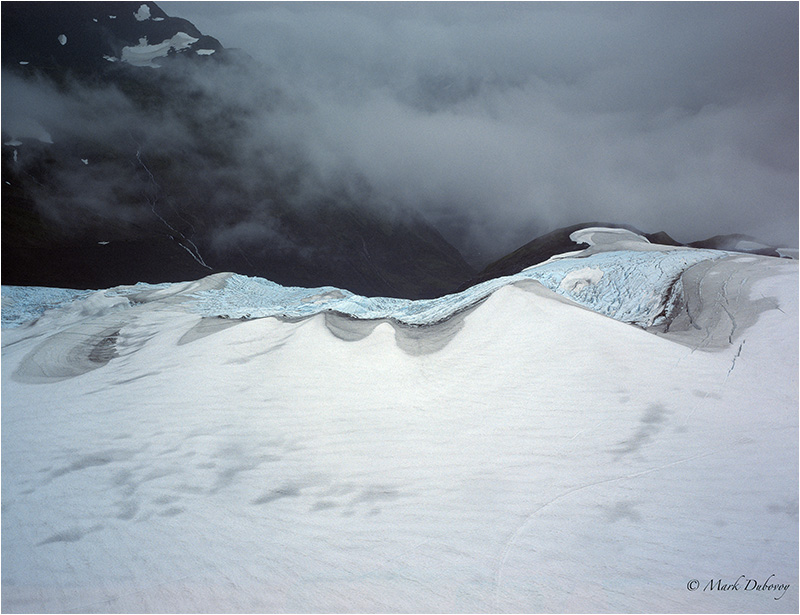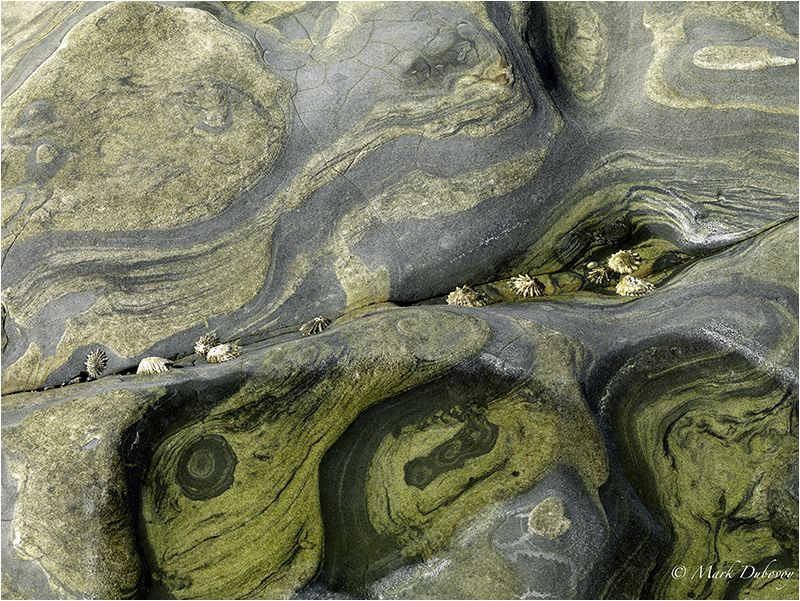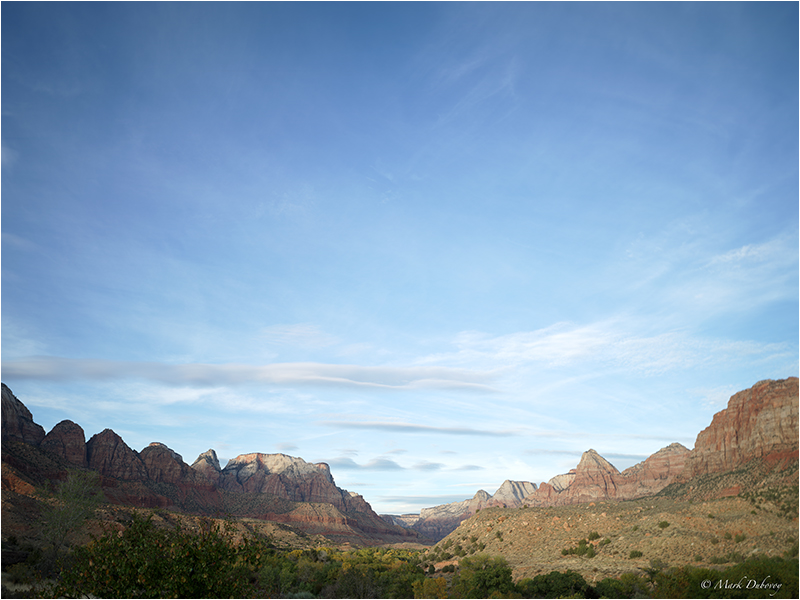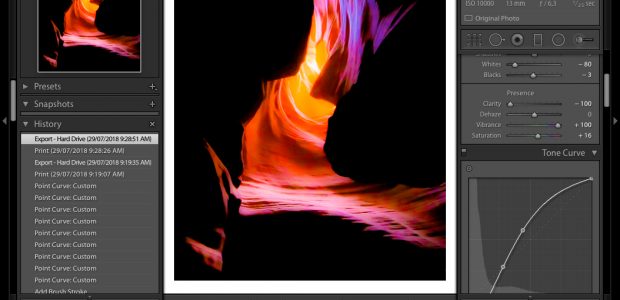
Glacier and Fog
Divergence
We have all heard and read about the “convergence” of video and still photography.
There are many still photographers that have a deep interest in video. There are a number of still photographers that have even made a total transition into shooting video only. We are all entitled to our passions, our hobbies and complete freedom to express ourselves in any way we wish. Therefore, I am delighted and fully support those that have found a new avenue of expression and pleasure (and for some, additional income) with video.
However, there are also huge numbers of photographers, including myself, who are simply not interested in video. Don’t get me wrong, I love and deeply admire good video work. I am a serious movie buff. I also love documentaries and fine art videos. But video is not my cup of tea when it comes to my personal passion or artistic expression. I would much rather try to tell a story in the quiet light, in a magical instant with a single still image and no sound. For me personally and for my work, nothing equals the impact of a fine print hanging on a properly lit wall.
Many photographers that are not interested in video (present company included) are beginning to get quite annoyed at the concept of convergence because it burdens them with additional complexity in their cameras with a series of functions and buttons that are completely unnecessary for still photography.
To make matters worse, often times the video functions spell disaster in terms of accidental activation and battery consumption, as well as compromises that result in bad ergonomics for still photography. It also can make the cameras and lenses more expensive because of additional design work, additional buttons dials and electronics, additional software, more expensive focusing or zoom motors for video, etc .
Unfortunately I have missed more than just a few great shots because of the “video creep” into still cameras.
Here are two classic examples:
1. The well known and widely reported problems with the video button in the Sony NEX 7 with the corresponding battery drain and sensor overheating. It took Sony and inordinately long time to finally come out with a “firmware fix”, but in my opinion the firmware fix is unacceptable. Getting a stupid message in the viewfinder and/or the rear display every time the video button is accidentally touched is idiotic and a huge annoyance for still photography. Unfortunately, this bad firmware design has now migrated to other Sony cameras like the RX1. Sony just does not get it…
2. The “M” button in the Leica M 240. The first time I realized what this button was all about, my immediate reaction was:Are you kidding me?An “M” (for “Movie”) button in a key position on the top plate of a Leica rangefinder still camera? How many serious rangefinder shooters need this? Worse, the button cannot be locked, it is extremely easy to accidentally activate it when putting the camera in and out of a bag and you get the dreaded battery drain, the long video of the inside of your camera bag and the corresponding overheating.
Why Leica put a video button you cannot lock in this key position and a critical button for still photography functions in a most uncomfortable location in the front of the camera is beyond me.
Leica just came out with their first firmware update for the M 240. Did they fix any of the major firmware issues for still photography (such as the fact that the Auto ISO function does not work in manual exposure mode) ? No, instead they fixed things such as the date in video mode. You can imagine how those of us that use M cameras for still photography feel about this.
Just as I complain about what is happening to the still cameras I use, many videographers bitterly complain about the compromises for video shooting that they suffer as a consequence of using cameras being originally designed for still photography. They like the look of the bigger sensors, but they do not like the rest of the cameras for video. For instance, lots of people shoot videos with Canon or Nikon DSLR’s, but have you seen the contraptions that they use in terms of brackets, gears for focusing, rear screen viewers, external microphone holders, external audio recorders (because the audio in DSLR’s sucks big time) and all that? These things look worse than Rube Goldberg contraptions.
I am afraid that much of what I say in this short essay may fall on deaf ears because of commercial considerations (based on superficial and often flawed analysis) but I am going to say it anyway:
What two very large segments of the photography market need is aDIVERGENCEof video and still photography.
While I welcome the possibility of shooting video and stills from a smart phone or other small devices, and while I can certainly understand that certain segments of the market such as wedding photographers like to shoot video and stills with the same device, there are huge numbers of serious videographers and serious still photographers who would much prefer equipment designed to shoot either still or video, but not both.
These large segments of the market would be much happier and much better served with divergence, not convergence.

Shells in Crevice
Simplicity
Simplicity is a very difficult thing. Some folks view simplicity (in a tool like a camera) as a lack of features. Others view it solely as the absence of clutter.
Neither concept could be farther from the truth.
Simplicity in a design is one of the hardest things to achieve. It implies that one has managed to implement every conceivable necessary function in an effective and efficient way. It also means that all superfluous or unnecessary functions have been eliminated. Simplicity by its very nature requires superb engineering in hardware and software design as well as a deep understanding of customer needs. But there is more, the whole device must feel aesthetically pleasing while at the same time providing state of the art performance and a sense of purpose. It is only when all these things come together that one can claim that simplicity has been achieved.
There are a number companies and products (some of which are extremely complicated) that seem to consistently achieve the goal of simplicity.
The classic example that comes to mind is Apple. Just look at the latest iPhone or iPad. The construction quality is exquisite, the design is a work of art. These are extremely complicated products, yet there is no clutter of buttons and dials or unnecessary functions. There isn’t even a users manual!
Let’s pause and think about that again: These products are massively more complicated than any camera (they include a still and video camera and even editing functions as part of the product), yet they are easy enough to use that the general public learns to use them without even needing a manual. I think this is a remarkable achievement.
Compare that with the fact that even expert, technically inclined photographers have to spend hours reading a manual for a typical DSLR before they can properly use it. Often times they even need to take a manual in the field to figure out how to do certain things that are too hard to memorize. Pretty silly, isn’t it?
Porsche Design is another name that comes to mind. They are famous for the phrase “form follows function” and some of the products they have designed over the years, from automobiles (like the legendary 911) to inexpensive ballpoint pens seem to achieve the simplicity goal.
One can look at any market, even something as mundane as vacuum cleaners or hand dryers and find companies like Dyson which produces clever, high performance, beautifully designed and disarmingly simple products.
There are products that achieve the simplicity goal near the high end of the price spectrum, but there are also many products that achieve the simplicity goal at very reasonable prices.
I believe that Adobe Lightroom is a good example of a product that achieves the goal of simplicity at a reasonable price.
Bottom line: I am a firm believer that simplicity can be achieved in just about any product at any price point as long as the right mindset and effort are put into understanding the customer’s needs, and the design and construction of the device and/or software.
Unfortunately, it seems that badly needed simplicity has been largely forgotten by practically all camera manufacturers.
Most of our cameras today are full of ugly clutter, convoluted menus, useless functions, an unnecessary explosion of buttons and dials, lack of direct simple access to critical functions, major ergonomic mistakes and big compromises.
I have an extremely difficult time trying to find a current camera that achieves the simplicity goal.
TheALPA FPSis probably the only currently manufactured still camera on the market that achieves the simplicity goal.
The Phase One IQ series backs pretty much also achieve the simplicity goal, so shooting an ALPA FPS with a Phase One IQ series back is truly a pleasure.
The Leica Monochrom with its elegant finish without logos or other “visual junk” (I wish every camera came this way!) comes extremely close to achieving the simplicity goal, but things such as the ISO setting procedure make it fall slightly short of the goal.
The Leica S system also comes close, but things such as those abhorrent lens hoods and the top display which cannot be seen in bright light make it fall short .
The Leica M 240 is one of the best color 35 mm format cameras on the market but unfortunately it misses the goal by a bigger margin due to “video creep”, a couple of ergonomic mistakes in the hardware, and current firmware issues.
The major SLR manufacturers (both, MF and 35 mm) as well as the MFT manufacturers fall so far below the simplicity goal that I view the situation as horrendously sad.
I wish someone would explain to me why a Pro camera needs insane convoluted menus with lots of items and procedures that make no sense. Why does Canon not allow one to do something as simple as set a camera for mirror lockup without having to either read the manual or memorize an idiotic arcane procedure?
Why does Nikon have two separate memory banks and why can one not lock the profile memory settings? One minor change (such as exposure compensation) for a single image and without warning the camera changes your profile for all subsequent shots. Ridiculous!
Why is it that in every SLR and every MFT camera I have tested something as simple as changing the ISO make us have to push buttons plus turn dials at the same time, or go to a menu? All these things are an abomination.
Why is it that the major camera manufacturers do not seem to be able to figure out even the most basic things, such as changing the exposure?
Dear camera manufacturers, there are 3 ways to change exposure: Shutter speed, aperture and ISO setting. So why don’t we get cameras with 3 controls, one for each function?
This is as elementary as it gets, and anything else seems dumb. Cameras in the old days of film had this. For example, I remember the old Rollei 6008 system. It had an aperture ring in the lenses and 2 dials, one for ISO and one for shutter speed. It worked like a charm. So what is happening with our newer cameras? Well, with very few exceptions they have disposed of the aperture ring and they usually give us only one or two dials, plus a bunch of buttons and/or menus. Dumb! The goal of simplicity is out the window, which means that the ergonomics, the performance and the usability of the cameras goes way down.
(In case you are wondering, one does not need to go back to aperture rings. The ALPA FPS has a clever multifunction dial in the FPS. This kind of multifunction dial would be a great approach to direct quick control of all 3 exposure functions. There are other approaches that would also do the job just fine).
It is important to note that I am not singling out just Nikon, Canon, Leica or Sony here. I could easily make similar comments (or worse!) about all other brands of rangefinder, SLR and MFT camera bodies: Hasselblad, PhaseOne, Panasonic, Olympus, Fuji, Sigma, etc.

Zion Panorama
Appeal
It is time to get off my soap box and end this short essay with an appeal to all camera manufacturers:
We need simplicity. We need you to cover the basics properly.
Give us the critical functions first. Think of the old motto that “form follows function”. Design for proper ergonomics.
Try and remember than humans have two eyes on the sides and noses in the middle so put the viewfinder and the screen in the right place.
Remember that human fingers are wider than a toothpick and cannot convolute into ridiculous positions.
Balance the weight. Give us a decent grip.
Give us 3 direct controls for exposure.
Use the viewfinder and screen of a camera properly; they are not a video game or a billboard where the goal is to try to cram every number, menu item and icon you can possibly cram into it.
And please, do not obstruct parts of the image with all this visual junk.Leave the image clean!
Finally, please make some cameras for serious pro level work that are not a convergence of everything under the sun, but rather the best suited machines to serve specific customer needs in the major market segments.
I do not think this is too much to ask.
Mark Dubovoy
October, 2013
You May Also Enjoy...
Turning Photographs Into Art Part 6: Printing from Lightroom Part B – Templates and Soft Proofing
FacebookTweet 1 – Introduction It is seeing original prints from master photographers that inspired me to create my own photographs and learn how to print them

